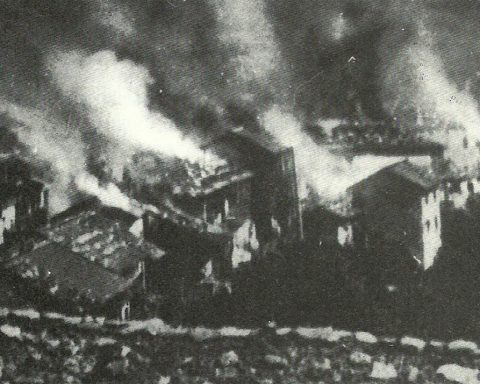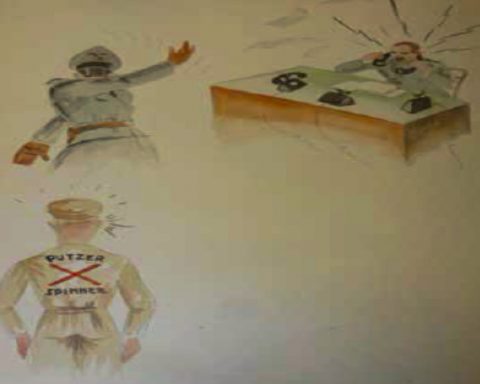A supreme commissioner, the Gauleiter of Tyrol Franz Hofer, was placed at the head of the OZAV. From the outset, Nazi policy in this area had envisaged the future annexation of South Tyrol to Germany and the “Germanisation” of Alto Adige.
In this context, South Tyrol became, especially during 1944, a territory where various people were deported to be used as forced labourers, in particular, in the factories of the satellite camps and in those annexed to the Polizei-und Durchgangslager of Bolzano. The concentration camp would also be an important tool for sending deportees beyond the Brenner Pass, where they would mostly be employed as forced labourers.
It must be remembered that in South Tyrol, 1939 marked not only the outbreak of the Second World War, but also the beginning of the well-known question of the “Options” for the German-speaking South Tyroleans, which gave them the opportunity to leave the province of Bolzano (and Italy) following the agreement between Mussolini and Hitler aimed at resolving the dispute over Alto Adige and the other German and Ladin “linguistic islands” in the country. The German-, Ladin-, Mòcheno- and Cimbrian-speaking population were asked to choose whether to become German citizens and consequently move to the territories of the Third Reich, or to remain Italian citizens and renounce acknowledgement of their status as linguistic and ethnic minorities.
With the “Options” we also partly move on to the question of work, and the consequent issue of sending manpower from and to South Tyrol/Alto Adige.
With some locals deciding to be “Optanten”, the business owners of this province were confronted with the need to re-occupy their vacated posts with similarly qualified staff at short notice. The “Options” started on 21 October 1939 and ended after 6 September 1943 due to the arrival of Nazi troops in the province. With regard to the general context of the war, it should be mentioned that the whole of OZAV, and the city of Bolzano in particular, was heavily bombed, and there was a massive use of generic manpower to reactivate the important railway line and for the removal and clearing of rubble.
In this province the Nazis also brought in workers from Eastern Europe (the so-called Ostarbeiter) because they were considered more productive than the workers of the Todt and in particular compared to the Italians, who were instead viewed as Brotgegessen, or “treacherous bread-eaters”.
It should be recalled that the territory of the province of Trento also fell under the OZAV with the consequent suspension of the sovereignty of the Italian Social Republic (RSI), but with some significantly nuanced differences compared to the province of Bolzano. The most evident concerned the position of Gauleiter Hofer and his consent for the appointment of the prefect commissioner, the lawyer Adolfo De Bertolini.
While De Bertolini managed to keep the Carabinieri corps operational, his actions were closely monitored by councillor Kurt Heinricher and Hofer’s local officials. Throughout Trentino there were repressive Nazi facilities, and the following bodies competed for the assignment of workers: the Todt, the Speer organisation and the Flak. Three were active in the “border” areas between Alpenvorland and the Italian Social Republic territory (in Ala, Riva del Garda and Torbole), while “security service” would subsequently be provided also by establishing the Trentino Security Corps (CST), who were directly trained by German officers.
Based on the consultation of papers held at the Trento State Archives, it appears that the documents produced during the De Bertolini period were pulped in the early 1950s. This makes it very difficult to reconstruct the history of labour exploitation in this region by the Third Reich.
Limited documentation has emerged so far, although we are aware of various roundups and anti-partisan operations, in particular in Val di Fiemme and Val Cadino, where several people were captured and then sent beyond the Brenner Pass or exploited locally by the Nazis as forced labour.
List of individual OZAV provincial areas of administrative boundaries

The list takes into account all the individual territorial areas of the OZAV within the administrative boundaries of the time (Günter Pallaver, Leopold Steurer [ed.], Deutsche! Hitler verkauf Euch! Das Erbe von Option und Weltkrieg in Sudtirol, Bozen, Raetia, 2011).
THE HISTORIANS’ VIEW
The Options of 1939 in South Tyrol and the fall in numbers of workers for German and Italian companies in the area.
Workers from the rest of Italy replaced the Optanten in agriculture and in the factories.
Generic and specialized workers in South Tyrol/Alto Adige.
Forced labourers in South Tyrol, the province of the Third Reich.
Workers in South Tyrol were like forced labourers in Germany and Austria.
by Antonella Triburzi and Costantino Di Sante







